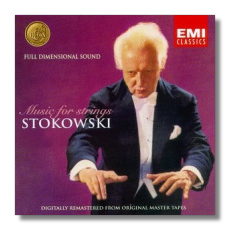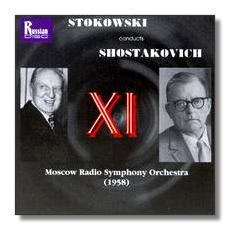
The Internet's Premier Classical Music Source
Related Links
- Latest Reviews
- More Reviews
-
By Composer
-
Collections
DVD & Blu-ray
Books
Concert Reviews
Articles/Interviews
Software
Audio
Search Amazon
Recommended Links
Site News
 CD Review
CD Review
The Stokowski Legacy - Part I

Music for Strings
- Henry Purcell: Hornpipe (from King Arthur Suite)
- Johann Sebastian Bach:
- Aria (from Suite #3)
- Mein Jeus, was für Seelenweh befallt dich in Gethsemane
- Preludio (Partita in E Major)
- George Frideric Handel: Tamburino (from Alcina)
- Christoph Willibald Gluck:
- Dance of the Blessed Spirits (from Orpheus and Eurydice)
- Lento (from Iphigenia in Aulis)
- Musette (from Armide)
- Luigi Boccherini: Menuet
- Niccolò Paganini: Moto perpetuo
- Alexander Borodin: Nocturne (from Quartet #2)
- Piotr Ilyitch Tchaikovsky: Andante Cantabile (from String Quartet #1)
- Sergei Rachmaninoff: Vocalise
- Joaquín Turina: La Oracion del Torero
- Theodor Berger: Rondino Giocoso
Stokowski Symphony Orchestra/Leopold Stokowski
1957-58 Stereo
EMI 65912


Stokowski Rarities
- Piotr Ilyitch Tchaikovsky: The Sleeping Beauty (excerpts) *
- Anatol Liadov: 8 Russian Folk Dances
* Stokowski Symphony Orchestra/Leopold Stokowski - 1948
Philadelphia Orchestra/Leopold Stokowski - 1934 Monaural
Iron Needle 1334


Dmitri Shostakovich
- Symphony #11 'The Year 1905' in G minor
Moscow Radio Symphony Orchestra/Leopold Stokowski
1958 Monaural
Russian Disc 5028


The Art of Conducting - Great Conductors of the Past
- Bach/Stokowski: Toccata & Fugue in D minor
- Ottorino Respighi: Pines of Rome
- Hector Berlioz: Harold in Italy
Stokowski Symphony Orchestra/Leopold Stokowski - 1957
Symphony of the Air/Leopold Stokowski - 1958 Stereo
L'Orchestre Nationale de France/Leonard Bernstein
EMI 72435 65921 2
It seems that the Stokowski Legacy is finally beginning to emerge. People are realizing that Stokowski's contributions to the art of interpretation and recording are, indeed, a legacy. A recent issue of the Sunday NY Times carried a lengthy essay about Stokowski written by Bernard Holland. In that article he maintains that The Stokowski Sound may be anathema to the 'period' people but that it is heaven to the rest of us. The number of Stokowski transcriptions being performed increases as can be read on the Internet and in other sources. Sawallisch has recorded Stokowski transcriptions with the Philadelphia Orchestra sounding as if Stokowski's spirit was with them. Riccardo Chailly will perform and record, with that same orchestra, Stokowski's version of Mussorgsky's Pictures at an Exhibition during the 1996 season. And the Maestro's own recordings come from various sources.
The important thing to ask when reviewing these issues is if the recordings do justice to the Stokowski Legacy. This is important because Stokowski's interpretations were also closely tied to his involvement in the recording process and the sound that he worked at in both. Thus, any recording which merely reflects what was done and not how it sounded cannot claim to be representative and is an injustice. In some cases there is reason to celebrate, in others not.
Well, let's start with the good. EMI has released Music For Strings. This full disc (78 minutes) will offer the listener a wonderful evening's music. Its contents were originally on two LPs: Music for Strings (SP 8415) recorded in 1957, and The String Orchestra (SP 8458) recorded in 1958. Stokowski's 'orchestra' was an ad hoc group drawn mainly from the New York Philharmonic Orchestra. It was a small body and Stokowski used the recording techniques to their hilt to get the massive sound he achieves (and Rob LaPorta has excellently reproduced). The music on this disc is not drenching but it is very beautiful. Having just finished listening extensively to two discs of Stokowski's Shostakovich 11th, this music is a balm. Throw away those New Age feel good discs, this is entertaining as well as relaxing. Strongly recommended as a tribute to the Stokowski Sound.
The Iron Needle disc is another matter. First of all, the cover incorrectly gives the date of the Tchaikovsky as 1934. The Sleeping Beauty was obviously taken from an LP, with headphones on you can hear the LP swish. The sound is thin, but the original LP was not a great sounding disc. This part is also plagued by wow and flutter that was obviously in a warped LP. But then there is the Liadov. That was undoubtedly taken from the Pearl CD (GEM CD 9031 with transfers by Ward Marten. I almost hate to say this, but the Iron Needle sounds better. It sounds as if a thin layer of surface noise has been removed and possibly it was transferred at a higher level. The results are a fuller sound with more bass. Still, this is half a loaf and I do not recommend this Italian release.
I originally thought that this Shostakovich 11th faced stiff competition from the EMI recording. This Russian Disc is monaural and is completely outclassed by the EMI recording. The mono sound is full and reverberent, but the consumptive contributions from the audience and a severe case of dropsy's from the percussion sections makes the disc impossible to listen to with headphones. These problems do not, however, equally affect listening through the speakers.
As to the interpretations, the differences here make a comparison more favorable to the live performance. The Russian orchestra and Stokowski produce a Shostakovich 11th that crackles and has a more earthy, raw and elemental sound to it. [Digression of sorts; at this point in the review I debated long about whether to use the word 'raw' or 'coarse'. The terms are really not synonymous, each carrying a different connotation. You may decide for yourself which term best describes what I am trying to get at here.]. The brass, in particular, are more menacing and the whole performance has a more sinister side to it than can be heard in the Houston recording. I wrote a friend of mine about this and she posed a couple interesting questions. Is this more sinister aspect a result of the orchestra's understanding of what Shostakovich was about or did Stokowski gain this insight and help bring that to the performance? My guess is that it is a bit of both. The end result is drenching, shattering. Furthermore, this live performance convinces me more that the 11th is a symphony and not a cine-symphony.
For those interested, the story behind this Moscow performance may be enlightening. Stokowski lead the U.S. première of Shostakovich's 11th with the Houston Orchestra 7 April 1958. EMI recorded it in sessions over 9-12 April 1958. Stokowski left shortly afterward for a tour through the Soviet Union. As usual he took a boat and train for his trip….none of those planes for him. He performed the 11th Symphony in his concert in Kiev in May. This Moscow recording was from the next appearance on 7 June 1958. Shostakovich was in the audience and they embraced at the end. We know that Stokowski and Shostakovich met several times over the years, though there's no evidence that they did on this occasion. The encore was Barber's Adagio for Strings. That performance can be heard on Music & Arts CD-787 (call [510] 525-4583) coupled with live performances of Messiaen, Ives and Britten (like that theme?). I thought about the questions eb posed. You know, it is quite possible that Stokowski, riding on his train, did get to feel the sinister aspect of the whole thing. Studying the score in his car, looking at a still scared country, talking with the people.
One thing I want to make clear, I am NOT recommending one recording over the other. At one point, whilst listening to the EMI release, I caught myself thinking, "I can't imagine any recording sounding better than this. And if it does exist, I am afraid of it." (An aside here: Stokowski was not satisfied with the lower register of the double bass and wanted to enhance it. He convinced the Allen Organ Company to construct an electric keyboard instrument to reinforce the double bass. This was used in the U.S. première and in the EMI recording. I first came across this information in Preben Opperby's biography of Stokowski. I talked with Stuart Warkow, who worked with Stokowski and the Symphony of the Air, and he confirmed that such a device was used by Stokowski on occasion. It was not used in the New York performance, shortly after the Houston one and before the trip to Russia. That, however, was more likely due to the fact that Stokowski had the organ pedal underline the bass. In cases where no such organ was available this small keyboard device, looking a lot like a Casio keyboard and located within the orchestra, created more frequency and boost to the lower strings. Here, again, we have an example of Stokowski using the latest technology to aid in producing the sound he was Symphony Orchestra famous for.) The Houston performance is a sonic wonder and the performance more poignant than the Russian one. It is almost as if we are hearing two sides of a Janus faced symphony. I would not want to be without either.
Now, we come to EMI's 7-disc set of The Art of Conducting: Great Conductors of the Past. The Stokowski items make up only about 1/14th of the set, but it is a nice segue into a strongly recommended set. Stokowski items included have been previously issued. The Bach was on The Orchestra (EMI 65614) and Respighi was on Leopold Stokowski: Symphony of the Air (an EMI issue of the United Artists recordings 5 65427-2; two discs). Let me say that I was much too harsh on The Orchestra in a previous essay. The sound is not as full as I would wish, but Rob LaPorta and his team brought out a lot more inner detail that was lost in the heavy reverberation Stokowski added. The result is more involving than was the LP. Anyway, you may already have these Stokowski items and not need to duplicate them. You will lose a lot if you decide not to make the investment.
For example, the Stokowski disc also contains Leonard Bernstein and the Orchestre National de France in one of the finest Harold en Italie (violist Donald McInnes) ever. Disc number four in the set contains George Szell's EMI recording of Dvořák's 8th with the Cleveland Orchestra and Doctor Szell sounding less strict and providing a wonderful performance with a lovely recording. (Both of these discs have been remastered and sound better than the original discs.) The Szell disc also contains Sir Thomas Beecham conducting Chabrier's Joyeuse March; Delius' Irmelin Prélude; and one of the greatest Tapiolas ever!! Then they throw in Sir John Barbirolli's recording of Elgar's Introduction and Allegro. Other gems from various discs are: Koussevitzky's Symphony #7 by Sibelius, Furtwängler's 1950 Vienna recording of Schubert's Unfinished Symphony; Felix Weingartner's 1938 London Symphony recording of Brahms Symphony #4; and an intriguing Oberon Overture with Arthur Nikish conducting the London Symphony in 1914!!!! There are also recordings by Ricard Strauss, Arutro Toscanini, Fritz Busch, Bruno Walter, Fritz Reiner, Otto Klemperer and Von Karajan.
Finally, and worth the price of the set alone, is a final disc that contains comparative studies in the opening movement of Beethoven's 5th from Arthur Nikisch, Wilhelm Furtwängler, Herbert Von Karajan and Otto Klemperer. Listening to the difference in the sound from Nikisch and Furtwängler is stunning. The interpretations different and both involving. Then comes rehearsal excerpts with Sir Thomas Beecham (Beethoven's Fifth: 3rd and 4th movements, 1951); Wilhlem Furtwängler (Beethoven's Lenore Overture #3 with the Stockholm Philharmonic in 1948); Sir John Barbirolli (Hallé Orchestra and Tchaikovsky's Fourth Movement from Symphony #6 in 1957) and back to Sir Thomas in Mozart's Ho! Wie will ich trumphieren (Gottiob Frick, bass, date unknown) and parts of Haydn's 100th Symphony with the RPO in 1958. Phew!
Copyright © 1995, Robert Stumpf II



















